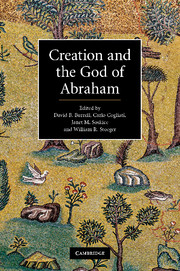Book contents
- Frontmatter
- Contents
- Contributors
- Preface
- Introduction
- 1 Creation ex nihilo: early history
- 2 Creatio ex nihilo: its Jewish and Christian foundations
- 3 The act of creation with its theological consequences
- 4 Scotistic metaphysics and creation ex nihilo
- 5 Creation and the context of theology and science in Maimonides and Crescas
- 6 Creation: Avicenna's metaphysical account
- 7 Four conceptions of creatio ex nihilo and the compatibility questions
- 8 Will, necessity and creation as monistic theophany in the Islamic philosophical tradition
- 9 Trinity, motion and creation ex nihilo
- 10 The Big Bang, quantum cosmology and creatio ex nihilo
- 11 What is written into creation?
- 12 Creatio ex nihilo and dual causality
- 13 God and creatures acting: the idea of double agency
- 14 Thomas Aquinas on knowing and coming to know: the beatific vision and learning from contingency
- Index
- References
10 - The Big Bang, quantum cosmology and creatio ex nihilo
Published online by Cambridge University Press: 07 September 2010
- Frontmatter
- Contents
- Contributors
- Preface
- Introduction
- 1 Creation ex nihilo: early history
- 2 Creatio ex nihilo: its Jewish and Christian foundations
- 3 The act of creation with its theological consequences
- 4 Scotistic metaphysics and creation ex nihilo
- 5 Creation and the context of theology and science in Maimonides and Crescas
- 6 Creation: Avicenna's metaphysical account
- 7 Four conceptions of creatio ex nihilo and the compatibility questions
- 8 Will, necessity and creation as monistic theophany in the Islamic philosophical tradition
- 9 Trinity, motion and creation ex nihilo
- 10 The Big Bang, quantum cosmology and creatio ex nihilo
- 11 What is written into creation?
- 12 Creatio ex nihilo and dual causality
- 13 God and creatures acting: the idea of double agency
- 14 Thomas Aquinas on knowing and coming to know: the beatific vision and learning from contingency
- Index
- References
Summary
INTRODUCTION
There is compelling evidence that our universe emerged from an extremely hot, dense primordial state about 14 billion years ago – the Planck era, which is often considered the direct result of the Big Bang. From that fiery epoch it has gradually expanded and cooled. And as it has cooled it has become more and more lumpy, and more and more complex. As ever lower temperatures were reached, simpler more basic entities and systems combined and formed an ever more complex and diverse array of evolving systems – particularly in cooler, more protected, more chemically rich environments.
But what is the Big Bang? Strictly speaking, it is the past limit of the hotter, denser phases we encounter as we go back farther into the history of the universe. Not only is it observationally inaccessible, but it also lies outside the reliability of the classical (non-quantum) cosmological models we depend upon. What will quantum cosmology be able to tell us about it? By considering the recent educated scientific speculation on what may have led to the Big Bang and the Planck era, we shall find that quantum cosmology – and the physics upon which it relies – promises to reveal a great deal, but cannot provide an alternative to the traditional philosophical notion of creation, creatio ex nihilo, in accounting for the universe's ultimate origin. Any understanding it might provide, no matter how physically fundamental, will require a deeper explanation or basis for its existence, order and properties.
- Type
- Chapter
- Information
- Creation and the God of Abraham , pp. 152 - 175Publisher: Cambridge University PressPrint publication year: 2010



